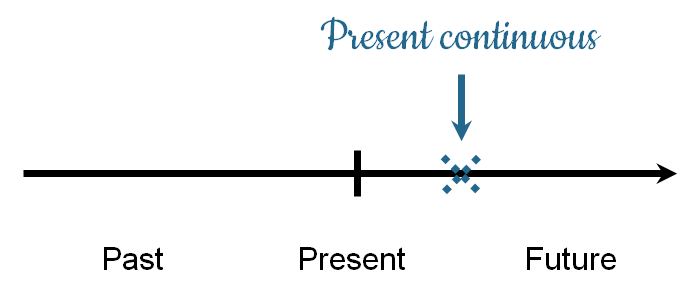Category: Tiempos verbales
El presente continuo se compone del verbo to be en presente y seguido del verbo con terminación -ing.
Usos del presente continuo
| To talk about something that is happening around the time of speaking but not necessarily at that exact moment (Longer actions in progress) Hablar de algo que está sucediendo en el momento de hablar, pero no necesariamente en ese momento exacto (Acciones más largas en curso)
|
Forma
Afirmativa: (am/is/are) + [VERBO + ing]
Ejemplos:
- I am watching TV now - Yo estoy viendo la televisión ahora.
- You are practicing English at the moment - Tu estás practicando inglés en este momento.
- He is working at the office right now - Él está trabajando en la oficina ahora mismo.
- She is playing volleyball - Ella está jugando voleibol.
- It’s raining today - Hoy está lloviendo.
- We are looking for a new apartment - Estamos buscando un nuevo apartamento.
- You’re studying mathematics - Ustedes están estudiando matemáticas.
- They’re thinking about buying a house - Ellos están pensando en comprar una casa.
Negativa: (am/is/are) + not + [VERBO + ing]
Ejemplos:
- I’m not reading the newspaper right now - Yo no estoy leyendo el periódico en este momento.
- He’s not writing a letter - Él no está escribiendo una carta.
- She isn’t dating him - Ella no está saliendo con él.
- It’s not snowing today - Hoy no está nevando.
- They are not doing their homework - Ellos no están haciendo su tarea.
Interrogativa: (am/is/are) + SUBJECT + [VERBO + ing]
Ejemplos:
- Are you going to the hospital? Yes, I am/No I’m not - ¿Vas a ir al hospital? -Si, si voy./No, no voy.
- Is he working today? Yes, he is/No, he isn’t. - ¿Está trabajando hoy? -Si, si está./No, no está.
- Isn’t she coming to dinner? Yes, she is/No, she's not. - ¿No viene a cenar? -Si, si viene./No, no viene.
- Is the computer working? Yes, it is/No, it’s not. - ¿Está funcionando la computadora? -Si, si está./No, no está.
- Are they coming? Yes, they are/No, they're not - ¿Vienen ellos? Si, si vienen./No, no vienen.
Puede agregar una palabra de pregunta (what, where, who, why, etc.) antes del verbo to be (am, is o are) para solicitar más información.
Ejemplos:
- What are you doing? -I’m eating chocolate - ¿Qué estás haciendo? -Estoy comiendo chocolate.
- Where is Santiago going? He’s going to the supermarket - ¿A dónde va Santiago? -El está yendo al supermercado.
- Who are playing chess? Brian and Richard - ¿Quiénes están jugando ajedrez? -Brian y Richard.
- Why is she crying? She fell down from her bicycle -¿Por qué (ella) está llorando? -Ella se cayó de su bicicleta.
Reglas ortográficas para [VERBO + ing]








